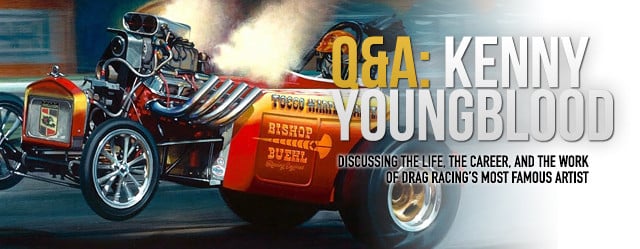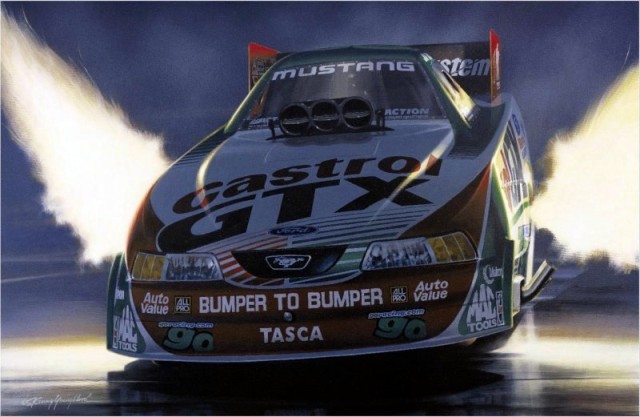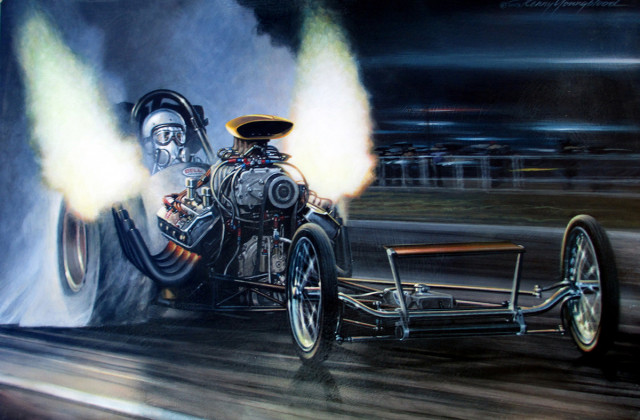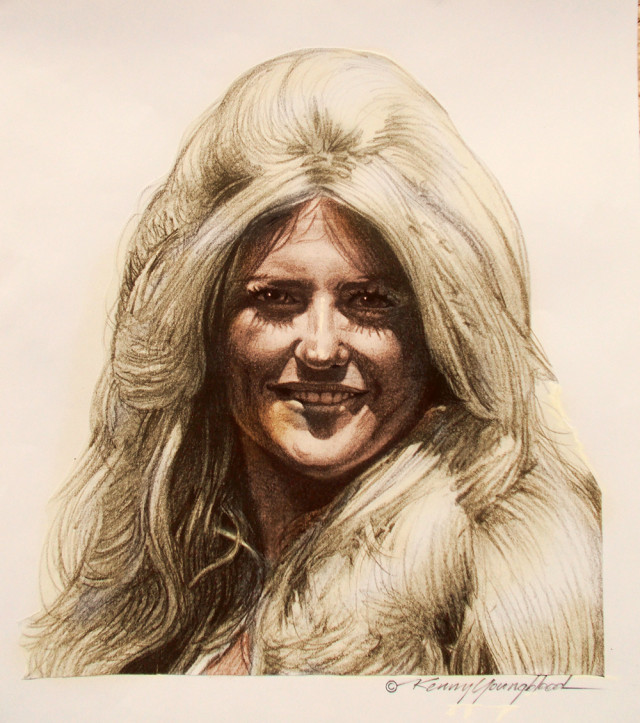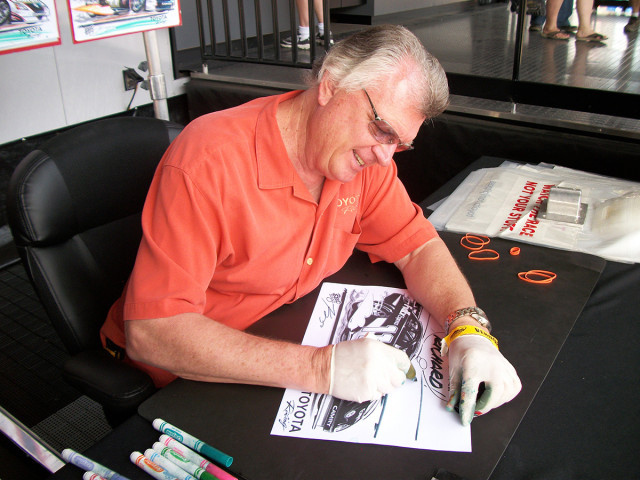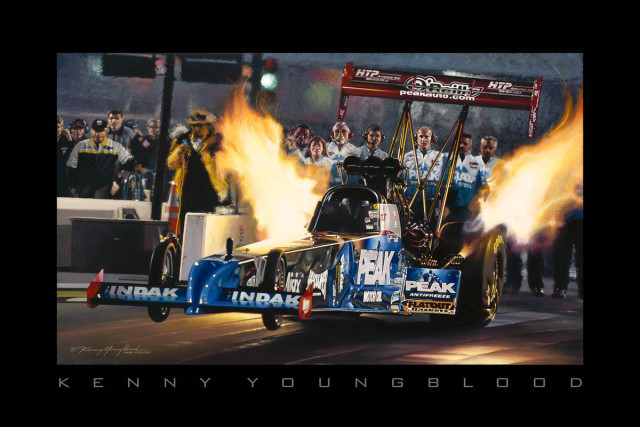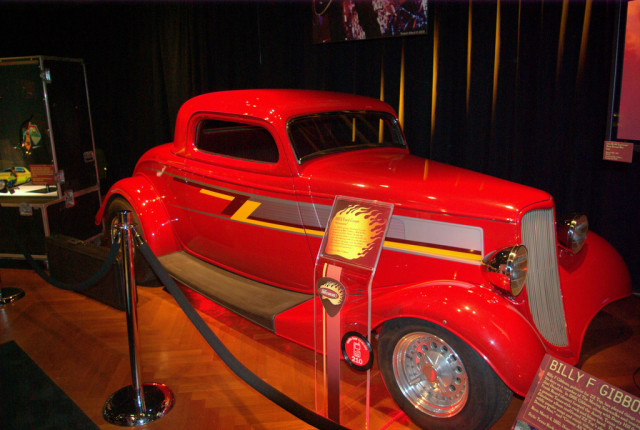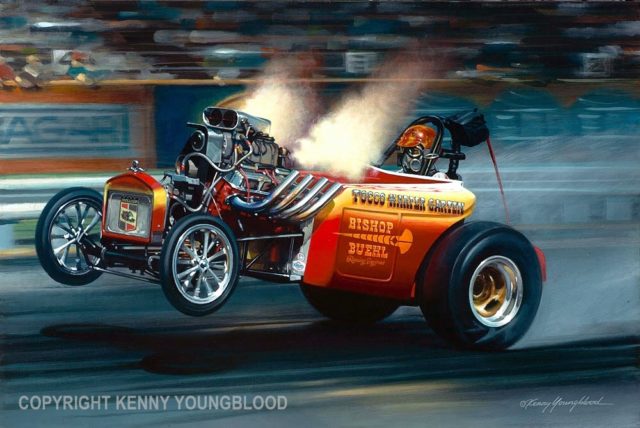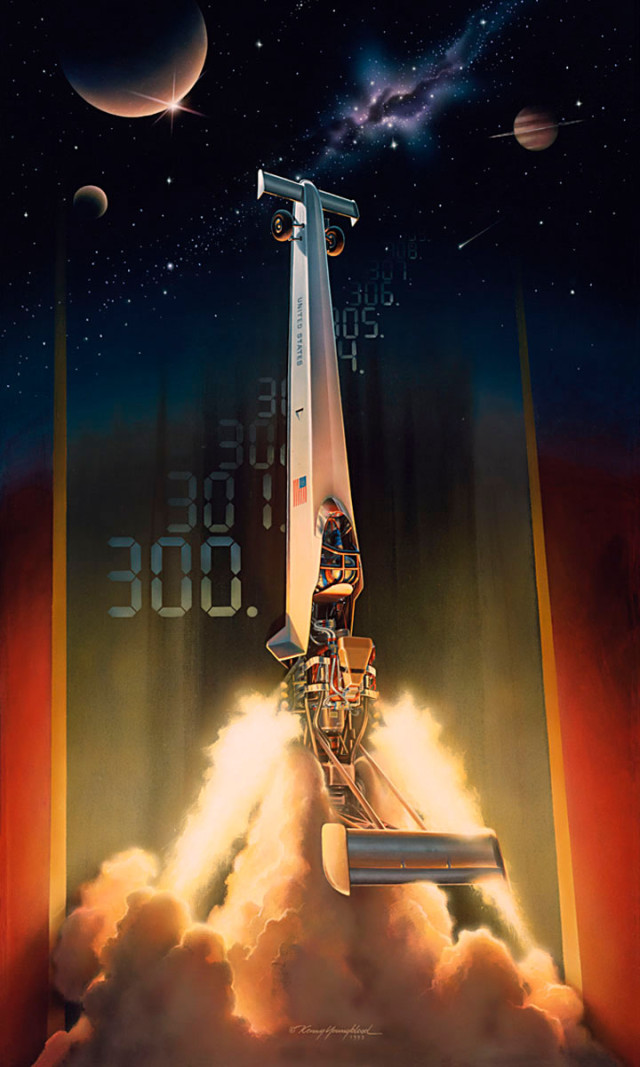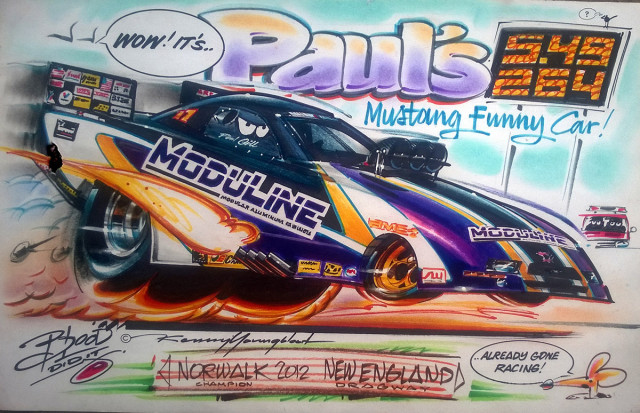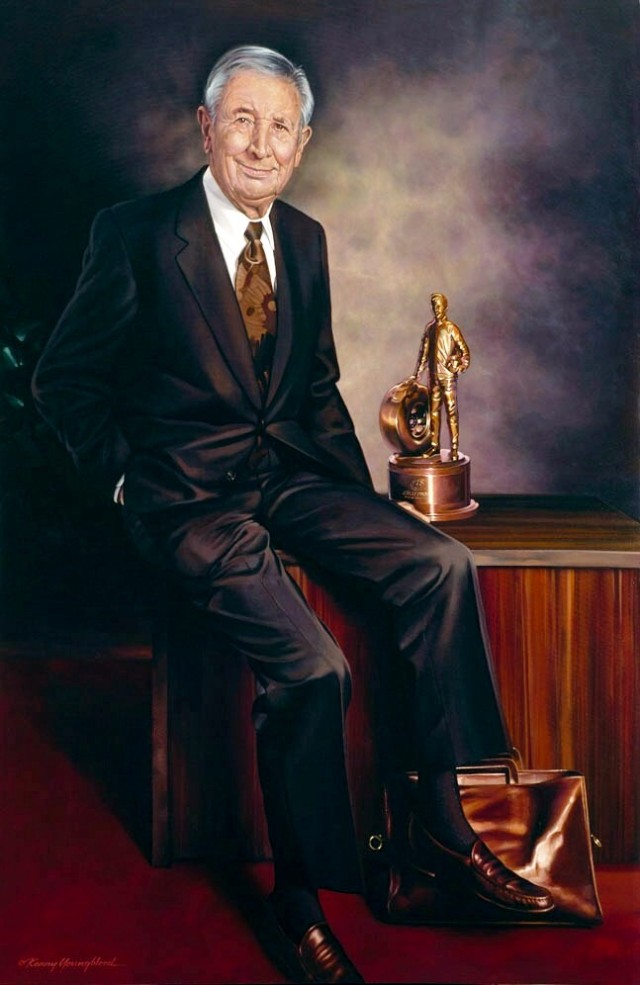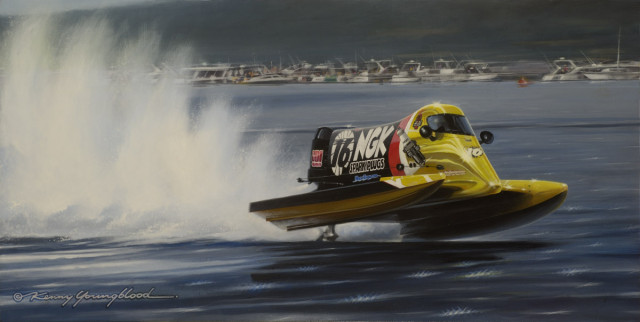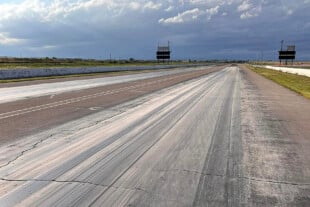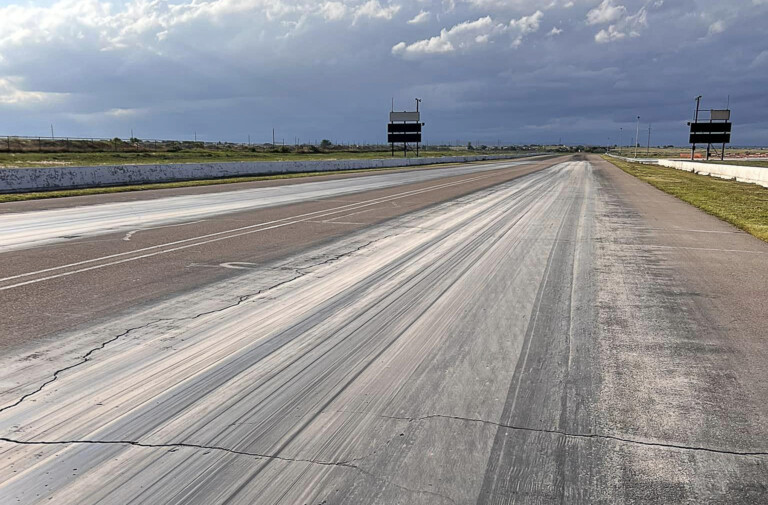Kenny Youngblood is the artist who single-handedly started the race car art industry. Kenny first lettered cars and then designed and painted actual paint schemes on cars before spreading out into fine art representations of race cars and scenes. Kenny’s workmanship could be found on most West Coast Funny Cars of the day, and as his reputation grew, he found himself traveling in every direction to paint racecars and even private street cars. Kenny’s work has decorated NASCAR and Indy cars and his paintings include Formula 1 and race boats, too. In addition, Kenny has owned and driven slingshot dragsters, managed off-road stadium racing teams, and even race boat teams.
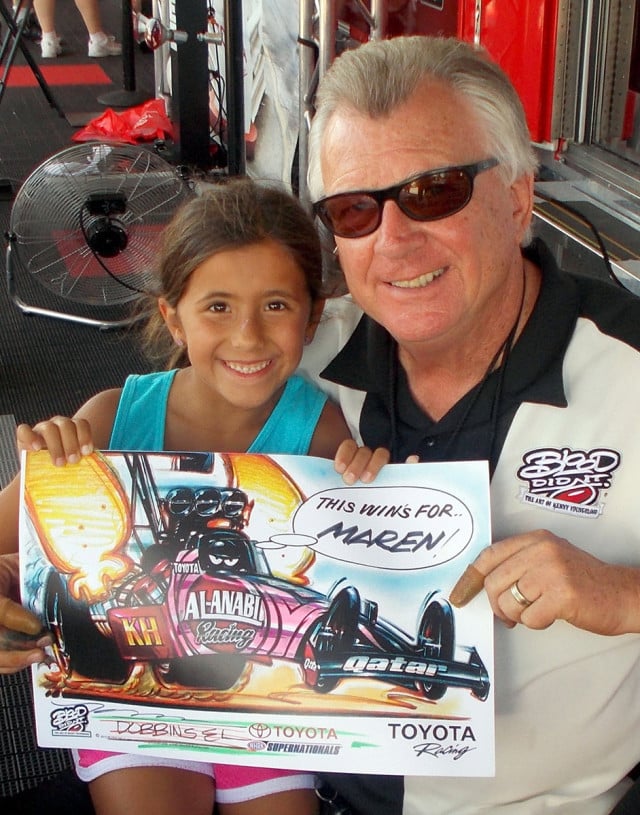 When I was asked to interview Mr. Youngblood, I eagerly accepted as Kenny and I have been close friends for at least 15 years. He and I were even partners in Fuel Coupe Magazine. Because of our relationship, I thought I knew him and his story well, but was I in for a surprise.
When I was asked to interview Mr. Youngblood, I eagerly accepted as Kenny and I have been close friends for at least 15 years. He and I were even partners in Fuel Coupe Magazine. Because of our relationship, I thought I knew him and his story well, but was I in for a surprise.
Dragzine (DZ): Where did you grow up and where do you call home now?
Kenny Youngblood (KY): I grew up in Rosemead, California (a suburb of L.A.), and have lived in Orange and San Bernardino Counties as an adult, and now live in Henderson, Nevada.
DZ: Have you always done artwork; when did you first realize you were talented in this area?
KY: I inherited the gift from a family of artists; been doing it from the hit.
DZ: Was your family supportive?
KY: Yes, very much so, considering that they were all into traditional subjects; landscapes, still life, portraits and such, while I was into mechanical things. My dad worked for Hearst Newspapers in Los Angeles, and would bring home stacks of blank newsprint and Ebony pencils; the perfect materials for me to draw with.
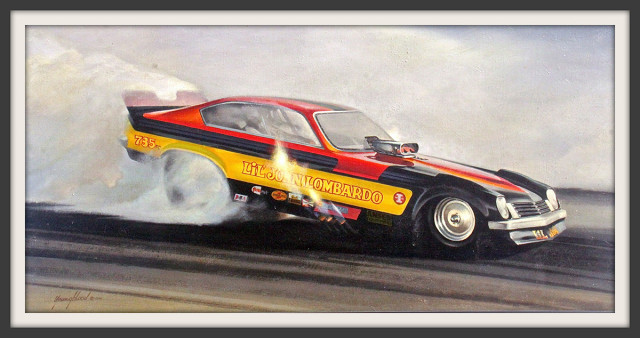
This never before published painting by Kenny Youngblood, depicts 70’s Funny Car star “Lil John” Lombardo, and his Vega Fuel Coupe. Painted in the mid-seventies during the era of long, smoky burnouts, it depicts the car in the late afternoon, with smoke starting to fill the cockpit, just before John steps off the gas.
DZ: Were other members of your family artistic?
KY: My mother, father, and uncle were all quality painters. My brother was somewhat artistic, but not as much as I was. My uncle, Lloyd Mitchell, was fairly well known as a western artist.
I was a pretty good student. Actually, I goofed off the most in art class.
KY: I’m sure I did, but don’t remember doing it that much. I was a pretty good student. Actually, I goofed off the most in art class.
DZ: What, if any, formal training have you had?
KY: I took art classes at Pasadena City College, figuring I would go to Art Center School and take transportation design. Back then, if you liked to draw cars, about the only place you could do that and get paid for it was in Detroit. The thing was, I liked hot rods and dragsters and, as it worked out, I never did go to Art Center School but got into the racing field. Actually, I guess you could say I pioneered the field of motorsports art; I was the first full-time artist doing strictly racing stuff, and surprisingly so for almost a decade.
My mother, Marie Youngblood, was the best art teacher I could ever have had; she had an astonishing knowledge of art. She loved art and was self-taught in all disciplines; painting, drawing, and sculpting. My parents came from rural Arkansas, where there was little to do about art, but she read every book on the subject she could get her hands on. Moving to Southern California in the forties, and with a family, she started taking adult art classes.
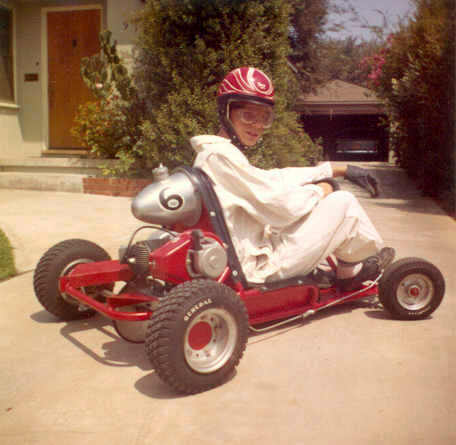
Kenny’s first pinstripe job on the helmet and lettering job on his Go-Kart and the family’s ’55 Chevy in the garage.
As a kid, I wasn’t very athletic. In fact, I’m really uncoordinated when it comes to sports. In Elementary school, I remember that we were tested under some ‘Presidential Physical Fitness’ deal; all the boys had to line up and throw a baseball as far as they could. My throw was so bad the teacher thought there was something wrong with my arm. In High School, the coaches all wanted me to go out for basketball (because I was tall) until they saw me play!
So, on the weekends my mom would take me with her to art museums, galleries, and live demonstrations in Los Angeles. We only had one car, so if my dad was working, she’d take me on the bus with her for the thirty mile or so ride into downtown L.A. There was this art store there named Duncan-Vail (I can’t believe I just remembered that), that would have live painting demonstrations by well-known artists. At one of them, the artist was going to do a portrait and needed someone to volunteer as the model and he picked me. My mom said kids are easier to paint than adults (less wrinkles) and I was the only kid there. When he was done, she tried to get the painting from him, but he wouldn’t go for it; she should have made it a condition up front, and living proof that most artists aren’t good at business!
Anyway, I sucked it all up like a sponge, learning more from my mom about the principles of art than I would ever learn from anyone else. The rules of art (perspective, composition, shading, color, etc.) are the same whether you’re painting the Mona Lisa or a valve cover. She taught me a lot of little tricks to making artwork easier and more accurate; things I still use to this day and every time I draw or paint. As well educated in art as she was, she seemed frustrated with her own work, so she concentrated on pouring her knowledge into me.
DZ: Did you have a favorite art teacher?
KY: Aside from my mother, there was only one teacher who ever really challenged me, and that wasn’t until I was in college. His name was Bill Bockus, and he taught an Advertising Design class when I was at Pasadena City College. Up until then, all my teachers would pretty much just put my work up on a pedestal and never really challenged me.
One day we were all working on a project in Mr. Bockus’ Ad Design class when he came over and asked me to come with him. He took me out into the hallway, where, propped up against the wall, where all the students work from the last class project, including mine.
He asked me how I thought my piece compared to the rest of the classes’ work. I told him mine was ‘probably better’. He not only agreed but said, “No, it’s a lot better. In fact, compared to the rest of the class, you should get an A+. But I’m only going to give you a C+, because that’s how hard you’re trying!” He didn’t say it in mean way, and he was right. He knew that in the real world, there are a lot of talented people and that I’d have to do my best.
DZ: Tell us about the progression of your work.
KY: My best friend’s dad growing up, George Kaiser, owned a machine shop, and would put us to work during the summers. I had taken drafting instead of machine shop in High School, so I wasn’t much good at running the machines. But George was also a motorhead and started building go-karts. One day he asked me if I could draw an exploded view of the go-kart, for the parts catalog. Now that was something I could do.
Lee Edwards, the President of the aerospace company George made parts for (Bertea Corporation, in Pasadena), was at the shop one day and saw my drawing. He told me to come up to Bertea; that they’d give me a job as a Technical Illustrator. Lee was a very stern, no-nonsense guy, so I did as instructed and they hired me on the spot! This was in about 1963 or so, and way ‘B.C.’ (before computers), so everything was hand drawn. I was probably eighteen or so, and was drawing the exploded view, assembly drawings of hydraulic flight-control systems for Boeing airliners.
Back then, tech illustrators in the aerospace industry, were required to use a drawing method called “Isometric Projection” (which I had learned in my drafting class), which called for the illustrator to take measurements off the actual blueprints and plot the part out in a drawing, based on a 30-degree angle view. Oval templates were used to make the circles and it was all done mechanically, with rulers, curves, and templates, as tech illustrators were usually people who were not necessarily artists; the templates allowed them to do the job without having to be ‘real’ artists.
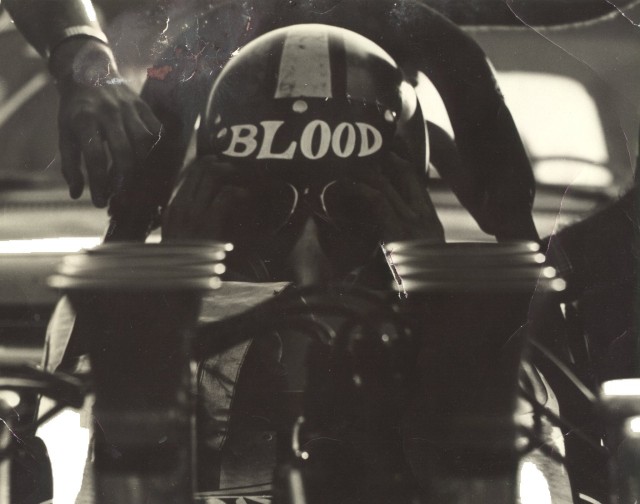
“That’s us in the Youngblood, Smith & Nassau “Skater” A/Fuel Dragster, circa 1968. My roommate and friend at the time, Dave Hussey, was an Engineer at Bertea where I worked as a Tech illustrator, and had designed a trick fuel metering valve for us; that’s Dave’s hand on the roll cage. The car ran 190’s in eight seconds; okay for back when they were still smoking the tires.”
It was a great job to have right out of high school and paid well enough for me to build and race the two A/Fuel Dragsters, from 1964 to ’69.
Doing the Isometric drawings was a snap for me and in fact was so easy it quickly became boring. So I started using some of mom’s tricks to speed up the process.
One day, the Chief Engineer brought me a new part to illustrate, along with a stack of blueprints two inches thick. It was an “Aileron Control Valve Manifold” for the ‘new’ Boeing 707 airliner. If you think that sounds complicated, you should’ve seen the part. The part I’m talking about is what you see under the wing flaps when the plane comes in for a landing. Those flaps are called Ailerons, and the complicated and very important valves that control them are the Aileron Control Valves.
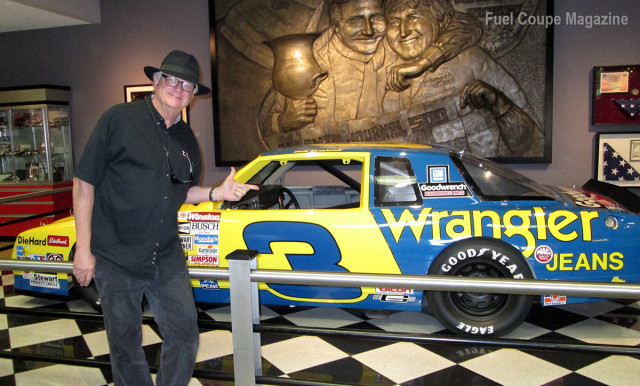
Kenny’s graphic design for Dale Earnhardt’s “Wrangler Monte Carlo”, and what would become the most recognizable numeral in history.
To do the drawing using the Isometric Projection method would have taken a week, so, knowing that the drawings are used for assembly only, and that they just have to ‘look’ like the part, I set the actual manifold on my drawing board at about a 30-degree angle from my eye, drew a 30-degree centerline on the paper and just started sketching it out by hand. I then went back and tightened up the drawing with the templates and a ruler and, viola, it was done!
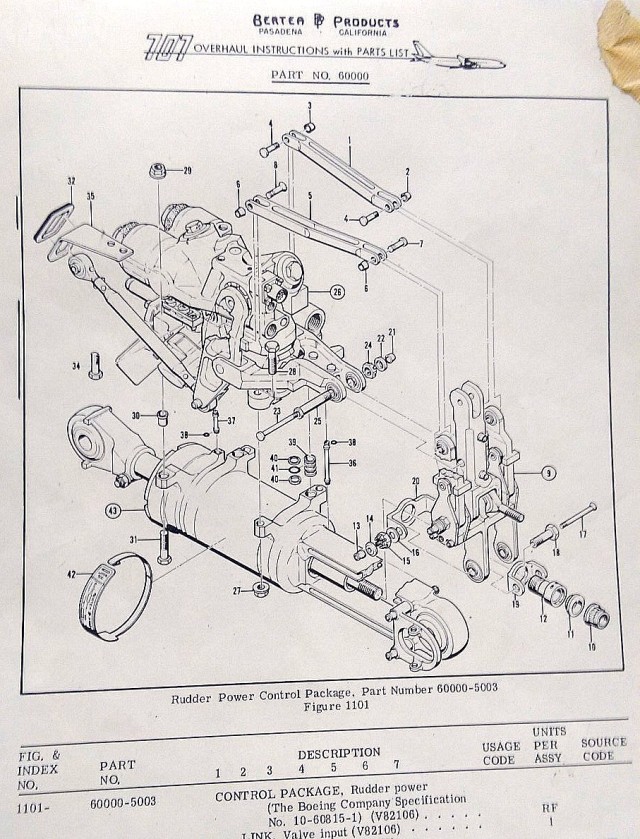
Kenny’s technical illustration of the Rudder Control Valve, for a Boeing 707 (done with the Youngblood method of “Fudge-O-Metric projection”).
When Mr. York came back by at lunch time and saw the drawing was all done, his jaw dropped in amazement as he asked me, “How’d you do that so fast?” To which I replied, ‘I used Fudge-O-Metric’!
I had, however, created my own demise, as I would get the drawings done so quickly that they couldn’t keep me busy. I’d spend my time BS’ing with the other employees until my boss had enough and gave me my walking papers. It was, however, a blessing in disguise as I would probably still be there had he not done me the favor of firing me.
I got into the artistic end of racing when, in about 1968, I did the lettering on a friend’s dragster. When the guy that had painted the car, Dick Olsen, of Competition Fiberglass in Bellflower, California, saw my work, he hired me on to be his and partner Don Kirby’s lettering guy. The friend whose dragster I lettered, by the way, was Gary Messenger, who fans will know from the beautiful “Future Flash”, Mendy Fry-driven Dodge Charger Nostalgia Funny Car we painted for Gary a few years back.
In the late seventies, we started doing the paintings and publishing limited edition prints, which was also a first. We were inadvertently the first to market ‘racing collectibles’ to the mass market; a market that wouldn’t come along until almost a decade later and would become a billion-dollar industry of its own.
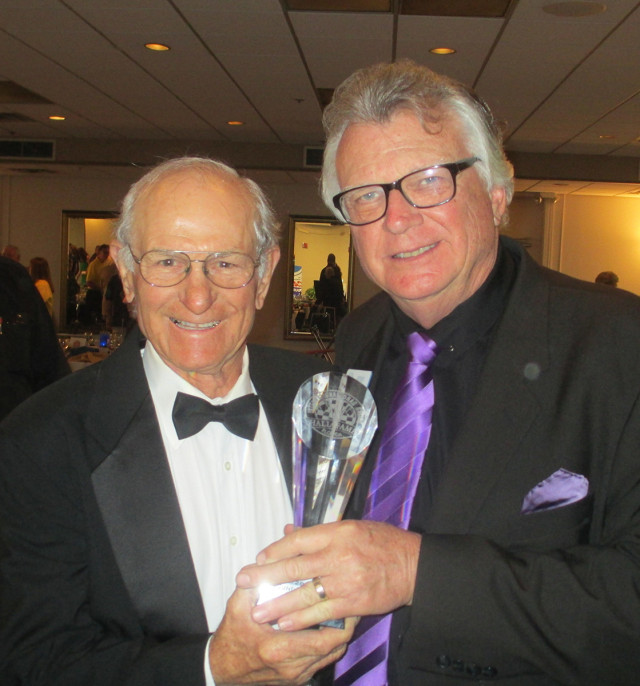
Kenny being inducted into the International Drag Racing Hall Of Fame, by “Big Daddy” Don Garlits in 2014.
DZ: Did you have any mentors?
KY: Yes, promoter Bob Kachler. I met Bob in probably 1970 or so, when I was working with Olsen and Kirby, and we hit it off immediately. Bob set me up in my first studio. It was Bob’s idea to have a one-stop creative shop for racers, and I was the in-house artist at ‘Racing Graphis’, in Long Beach, California. Bob helped me with the business end of art when I was first getting started; I owe him a great deal. The racers didn’t know me, but Bob knew them and got my name out there. He also introduced me to Terry Cook, who was the Editor of Car Craft Magazine at the time. Getting in the magazines was like being on TV is today; you go from unknown to celebrity overnight.
DZ: What other artists work do you admire?
KY: When I was a kid, there really weren’t many guys drawing race cars. I remember seeing Burnett’s cut-away drawings in the late fifties, and was really blown away by Joe Henning’s stuff in Rod & Custom Magazine. Then, of course, there was Robert Williams and Harry Bradley; two artists about as far apart creatively as you could get, but both geniuses.
[Nostalgia Funny Car racing] is not only as close to ‘The Good Ol Days’ as we’re ever going to get, it’s better! It’s better because we appreciate it more now.
DZ: What mediums do you prefer to work with?
KY: Ones that dry fast! My parents painted in oils and I grew up disliking their nasty smell, plus they dry way to slow for me; it would drive me crazy to have to wait for days for something to dry. When I’m using water based paints, I usually have the paint brush in one hand and a hair dryer in the other. If I’m drawing, I use pens, pencils, chalk and Crayola markers.
DZ: Do you use the computer in creating your artwork?
KY: No, I wish I knew all that stuff; it makes things a lot easier for most commercial art jobs; but I’m strictly old school.
DZ: How did you get interested in racing and, specifically, Funny Cars?
KY: I got hooked my first time at the drags, at San Gabriel, about 1958. I was always into cars, and consider myself a racer at heart. After racing the dragsters, I fell in love with the Funny Cars at Lions, in 1969.
DZ: What do you like best about Nostalgia Funny Car racing?
KY: It’s not only as close to ‘The Good Ol Days’ as we’re ever going to get, it’s better! It’s better because we appreciate it more now. The ‘boss’ cars, the nitro, the people, the racing, the camaraderie; you just can’t beat it. The things I like best about Nostalgia Funny Cars are the same things we all like; the cars look like cars (instead of inverted Jello molds), they have character, they sound bitchin’, they put on a show; I could go on and on but you already know.
DZ: Who’ve been your favorite racers to work with?
KY: That’s tough; there have been so many. My favorite racers to work with in the design end of the business have been the ones that care as much or more about how their cars look as how they run; the guys that want to win ‘Best Appearing Car’. Back in the day, there was the Custom Body guys (Fred Castronovo, Nick Montana and Angelo Cassaro), Kenney Goodell, Raymond Beadle, Bill Bagshaw, Al Segrini, John Mazmanian, Don Cook, the Condit Brothers; there are too many. Then there were the guys that were side-splitting funny, like Gene Beaver.
As far as the paintings go, my favorite racers are anyone who steps up and wants to have a portrait done of their car; anyone who appreciates the work. Art is a funny thing; just because someone can afford it doesn’t mean they appreciate it or want it.
DZ: What are some of your favorite pieces (of your own work)?
KY: The “Beyond 300” painting stands above anything I’ll ever do, concept wise; it was an inspiration from the Lord above. There are a lot of others I like for different reasons; usually, because the subject made a big impression on me as a teenager or an adult who loved drag racing. I rarely paint something just for the money or that I don’t really love; you have to love what you’re doing. Cars like the Speed Sport Roadster, “Flamin’ Frank” Pedregon’s coupe, the “L.A. Hooker”, “Mooneyham & Sharp” and the “Surfers” represent cars and drivers I was in awe of.
DZ: Do you do subjects other than racing?
KY: Just about done it all, but I love the race car stuff the most. I’m working on a series of paintings depicting Las Vegas right now.
DZ: What/who inspires you?
KY: The Good Lord and anything on nitromethane at night!
DZ: Do you have any rules or philosophy on creating your artwork?
KY: I do the easiest, most fun part first. Then the next most fun part and so on. The hardest part will be the last thing I do, but then it’s all done and I’ve enjoyed doing it every step of the way.
Art is a funny thing; just because someone can afford it doesn’t mean they appreciate it or want it.
KY: Sometimes it’s just a piece I want to do, but usually it’s a combination of that and what I think will sell. I’ve always had a good eye for what people would like to see and would buy; the same things I’d like to see. Of course, a lot is commissioned work, so I’m not picking the subject matter, the client is.
DZ: What don’t our readers and your fans know about you?
KY: I was Crew Chief for Gillman Racing’s Off Road and Formula-1 Tunnel Boat Teams, during the 1980’s. We dominated stadium off-road racing and then went from rookies in 1986, to winning the U.S. Championship with the Tunnel Boat, in 1990.
I, of course did our team’s graphic designs as well as for some of the other teams, like the Wendt Brother’s “Old Quaker”.
DZ: What are your other interests?
KY: I’ve been blessed with Terri, a wife who’s enjoyed the same things I have over the years; snow skiing, playing billiards and of course, racing.
My passion, however, is the counseling ministry the Lord called me to, many years ago; the most rewarding thing we can do and the reason we’re here is to help others.
DZ: What about your favorite personal cars, hobbies, foods, TV shows, and movies?
KY: I’ve got a ’72 Buick Riviera I’ve been working on for way too long, but it’s going to be really nice when it’s done. I like interior decorating, Italian food and the ID channel. Favorite movies are “Jesus Of Nazareth”, “Casablanca” and Marlon Brando’s “One Eyed Jacks”.
DZ: What are your immediate and future plans?
I always tell students to keep things in perspective; that the artistic process is that of ‘fixing what’s wrong’.
DZ: What advice would you give those who’d like to expand their own artistic horizons?
KY: I always tell students to keep things in perspective; that the artistic process is that of ‘fixing what’s wrong’. The artist always looks at their own work critically; always seeing what’s wrong with it. If they didn’t, they’d never get any better. There’s always going to be someone who does better work than you, but millions of people who aren’t as good as you; just do your own thing and follow your passion.
In this computer age, I also advise students to learn digital graphic tools like Photoshop, as 99.9 percent of everything commercial is done digitally these days. If you want to be a fine, no computer artist, go for it; there will always be a place for that. But, if you want to do things commercially, like it or not, digital is how it’s done. Plus, a person with an eye for art but who isn’t perhaps that good at actually doing it, can let the computer become their brush. This, of course is why us old school artists are in less and less demand, but that’s the way it is.
Also keep in mind that it’s the ideas, the concepts, that are the most valuable; no matter how simple. Take for example the ‘Hoola Hoop’ of the 1950’s; imagine the person who invented it trying to sell their idea by drawing a circle on the floor with a piece of chalk and saying, there it is, folks!


